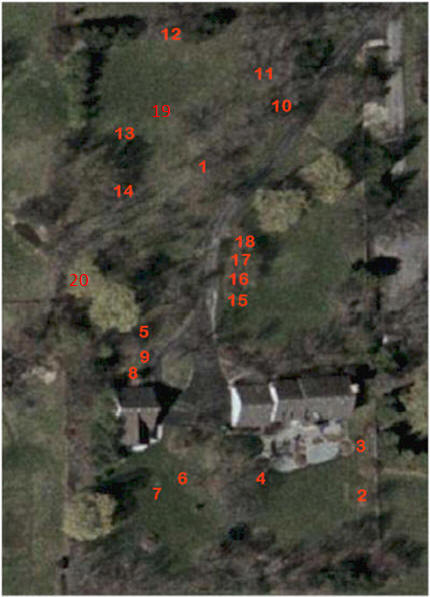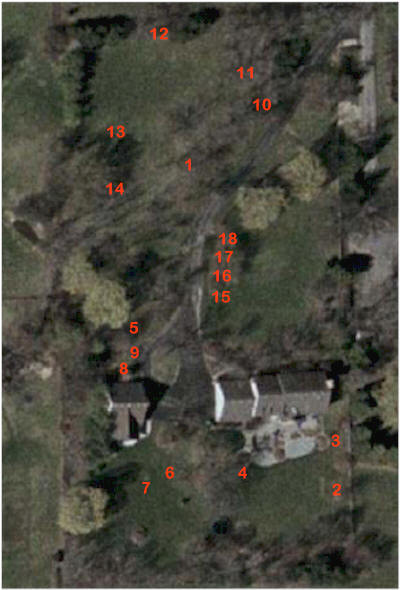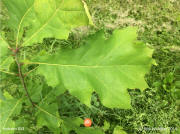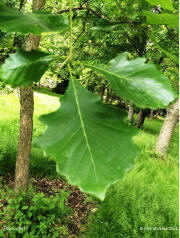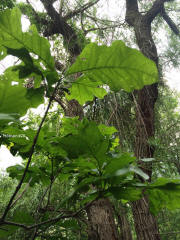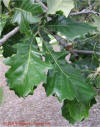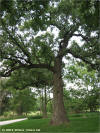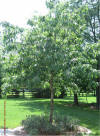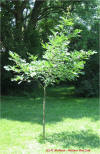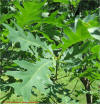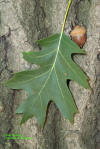| | | | McNees' Hobson Oak Trees & Wildlife |  | The symbol to the left represents the twenty (previously eighteen) oak trees on our property - a small fraction of the more than six hundred trees and bushes we've planted since we've been here. As they mature, we're thinning out the lesser and faster growing trees that provided shade and ornamental vegetation over the years as the slower growing oaks grew. These twenty oaks are spotted on the map at the right. Many of the trees shown have already been removed to make room for the maturing oaks. Trees numbered 19 and 20 were planted from acorns on the site and have been added to the list and to the map accordingly. The species represented are shown below. |
| |
|
With trees also comes wildlife. In addition to deer, foxes, racoons, coyotes and wolves, we've had some very interesting wild birds too. In addition to the ducks, geese, an occasional humming bird, the various woodpeckers and colorful Bluejays and Cardinals, the most intriguing are Great Horned Owls (below right) that are now resident. Often heard at night, they are seldom seen and are very elusive until recently. While this picture doesn't show it, they stand more than twenty inches tall.
| |
|
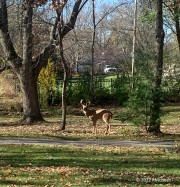 |
 | |
| 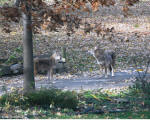 | 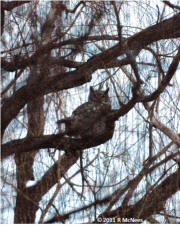 |  |
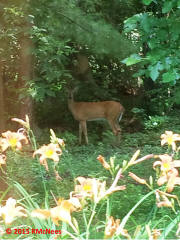 |
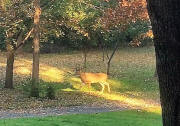 |
|
| | A pair of coyotes,
owls, and a deer visiting our property. |
| | | | Black oak (Quercus velutina) | | This is a large tree, sometimes growing more than 100 feet in height. The thick, nearly black bark is marked with deep furrows and irregularly broken ridges. The characteristic inner bark is bright yellow to orange, hence the alternate common name. This tree grows on dry uplands, slopes and ridges. The wood, while hard and strong is not tough, checks while drying and generally is inferior to that of the Red Oak. Still, it is used in much the same ways. Historically, the inner bark was important for its tannin and as a source of yellow dye. The bitter acorn is inedible. | 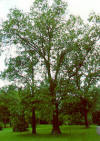
|  |  | | | | | Black Oak Full | Black oak leaf | Black oak bark | Black oak fruit | Black oak flower | |
| | | | | | | | "The Hobson Oak", purportedly the oldest tree in Dupage County. Green Farm Oak at Greene and Hobson. (Rt) | | | | | Bur oak (Quercus macrocarpa) - 6, 9, and 13 | | The Bur Oak is known as the long-lived majestic oak tree. The tree is tolerant to urban conditions and adapts well to various soils. The leaves of the Bur Oak are 4 to 10 inches long with Autumn colors of yellow-green, yellow, and yellow-brown. The Bur Oak is a tall, fairly slow-growing, long-lived tree, highly desirable for windbreaks, shelterbelts and ornamental use. It has an impressive crown with a massive trunk, which makes it a picturesque specimen. Bur Oak trees adapt to various soils where other oaks may fail.The fruit of the Bur Oak is an acorn that ripens in the fall and is over half covered by a fringed cup. This deciduous tree is tolerant to urban conditions. Autumn colors are yellow-green, yellow, and yellow brown. The tree will bear acorns in the nursery in ten years. | 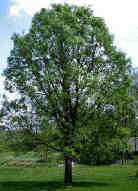
|  |  
| 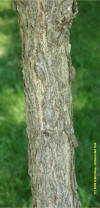 |  |  
|  | Bur Oak Full | Bur oak leaves | Bur oak bark | Bur oak fruit | Bur oak flower |
| | | | | Chestnut Oak (Quercus prinus) - 11 | | The Chestnut Oak tree, Quercus prinus, is a medium-sized, native, deciduous tree. Chestnut Oak trees are also called Rock Oak, Rock Chestnut Oak, or Mountain Oak. It is long-lived and slow-growing rugged tree. The characteristic bark is dark and very rough. On older trees it typically is broken into long, V-shaped ridges that are separated by deep furrows. The tree grows on dry, rocky ridges and slopes. The wood is strong and durable, and mainly used for general construction and fuel. The bark has greater tannin content than most other oaks, and was extensively used in the leather tanning trade. The acorns are an important source of food for various forms of wildlife. The acorns are large, but do not appear until the tree is around 20 years old. The leaf undersides are medium green, rather than white. Autumn color is chartreuse to yellow-brown, but the canopy is cleaned of leaves by late autumn. Chestnut Oak is amazingly free of major pest and disease problems, a testament to superior genetics in all aspects of its growth cycle. | | Chestnut oak page Virginia Lohr, Department of Horticulture and Landscape Architecture, Washington State University | 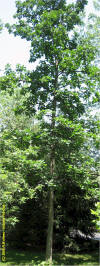 | 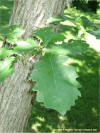 | 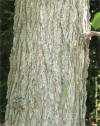 | | | | Chestnut oak full | Chestnut oak leaves | Chestnut oak bark | | |
|
| | | | English oak (Quercus robur) - 10-12 | English Oak, as its name implies, is an Oak tree native to England (or more accurately Europe, northern Africa, and western Asia).
It is similar in leaf appearance to White Oak, but does not have its spreading majesty with age or its reddish foliage color in autumn. Under landscape conditions in urban environments, it may reach 50 feet tall and 50 feet wide. It is being increasingly used as genetic stock to generate hybrids with other members of the White Oak group, for use as landscape shade trees. As a member of the White Oak group and the Beech Family, it is related to the Beeches, Chestnuts, and other Oaks. | | English oak page - Virginia Lohr, Department of Horticulture and Landscape Architecture, Washington State University | 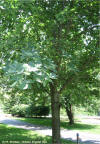
|  |  | 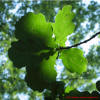 | 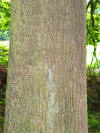 |  |  | | English oak full | English oak leaves | English oak bark | English oak fruit |
| | | | | Pin oak (Quercus palustris) - 1,2, 5, and 15, 16, 17 and 18 | | The Pin Oak tree, Quercus palustris, is probably the most widely used native oak for landscaping. One of the faster growing oaks; it can grow 12 to 15’ over a 5 to 7 year period. Pin Oak trees have moderate water requirements and have a moderate tolerance to salt and alkali soils. This deciduous tree prospers in a range of soil types including wet soils. It has pyramidal, dense, pendulous lower branches when mature. It loses it lower limbs with age. Young trees and lower branches of older trees hold leaves throughout winter. Transplants well. | | Pin oak page - Virginia Lohr, Department of Horticulture and Landscape Architecture, Washington State University | 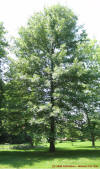
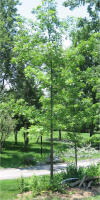
| 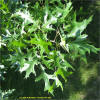
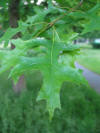

|  
|  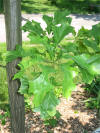

| 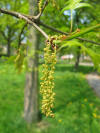 

| Pin oak full | Pin oak leaf | Pin oak bark | Pin oak fruit | Pin oak flower |
|
| | | | | | | | Scarlet oak - (Quercus coccinea) - 7 | | Scarlet Oak is found throughout much of the Eastern United States, and within Ohio is found abundantly in the eastern half of the state, and modestly in the southern counties, but is rare elsewhere. This Oak is frequently confused with Pin Oak (the shapes of their leaves and young trees are similar), and also with Black Oak, Red Oak, and Shumard Oak on occasion. Scarlet Oak, as its name implies, can have the best fall color of any oak, but many trees are more russet than flaming scarlet, and its best growth only occurs on acidic soils. Scarlet Oak is an inhabitant of dry ridges, bluffs, and hills due to its superior drought tolerance. It may reach 70 feet tall by 50 feet wide at maturity, when found in the open. As a member of the Red Oak group and the Beech Family, it is related to the Beeches, Chestnuts, and other Oaks. | |
|
| | | | -
Swamp white oak (Quercus bicolor) - 13 | | The Swamp White Oak tree, Quercus bicolor, is a beautiful native tree with lustrous, heavy textured leaves with wavy margins. This rugged oak grows well in either upland or swampy areas. It is tolerant of poorly drained sites and frequently is found in heavy mucky soils. The Swamp White Oak is a rapidly growing tree that flowers in spring. The acorns mature and are shed in September or October of the same year. The Swamp White Oak is a long-lived tree that may reach 300 to 350 years old. The name bicolor refers to the two-colored leaf, shining dark green above and velvety white pubescence below, turning golden in the fall. This deciduous tree has a rounded open habit. Swamp Oak trees transplant easily. It casts dense shade. The sweet acorns are eaten by whitetail deer, mallards, wood ducks, wild turkeys, squirrels, woodpeckers, and smaller rodents. | 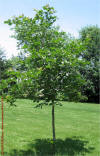
|  
|  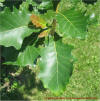
| 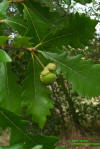 |  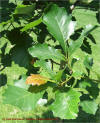
| 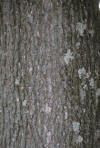 | | Swamp white oak full | Swamp white oak leaves | Swamp white oak | Swamp white oak bark | | | | | | White oak (Quercus alba) - 8 | | White Oak is the official state tree of Illinois. The White oak is fairly tolerant of a variety of habitats, and may be found on ridges, in valleys, and in between, and in dry and moist habitats, and in moderately acid and alkaline soils. The leaves are entire and variously lobed. Sometimes the lobes are shallow, extending less than half-way to the midrib, but sometimes they are deeply lobed, with the lobes somewhat branching. The bark is a light ash-gray and somewhat peeling, variously from the top, bottom and/or sides. The acorns are long and thin relative to most oaks, and are a valuable wildlife food. Acorns of White oak were used by Native Americans as a food; they are much less bitter than the acorns of red oaks. They also are a favorite food of turkeys, wood ducks, pheasants, grackles, jays, nuthatches, thrushes, woodpeckers, rabbits, squirrels and deer. The White oak makes an outstanding shade tree, with an exceptionally wide spread and almost never dropping limbs. However, it does not tolerate urban conditions well, although it may thrive in residential neighborhoods. It is sometimes confused with the Swamp white oak, a closely-related species, and the Bur oak. | | White oak page - - Virginia Lohr, Department of Horticulture and Landscape Architecture, Washington State University | 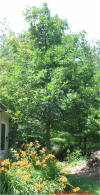
| 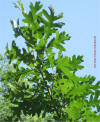
 | 

| 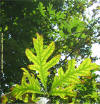 | 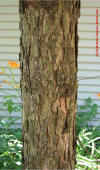 |  | 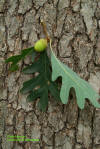 
|  |  | | White oak full | White oak leaves | White oak bark | White oak fruit |
| | | | | | | | | | | Tree Links - Sources, Credits
| | | | Tree Identification - Recommended by Ms Kent's Goodwin CC Class! | | | Arbor Day | | | | | | | | | | 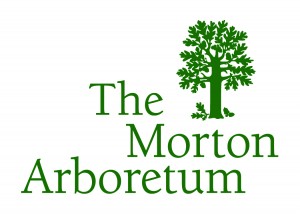 | The Morton Arboretum in Lisle, Illinois, was established in 1922 by Mr. Joy Morton (1855-1934), owner of the Morton Salt Company. Its mission is to collect and study trees, shrubs, and other plants from around the world, to display them across naturally beautiful landscapes for people to study and enjoy, and to learn how to grow them in ways that enhance our environment. Our goal is to encourage the planting and conservation of trees and other plants for a greener, healthier, and more beautiful world. | | http://www.mortonarb.org/ |
|
| | | "Wood Barns and More! - Identify that Tree"
http://www.alansfactoryoutlet.com/wood-barns-and-more-identify-that-tree / | | | This site used and referred by Alyssa Britton 's 7th Grade Science Class at NCP Charter School
in Grand Prairie, Texas for their 'Trees' science project. | | |  | | | | | | | | | | | | | | | | | | - Minnesota Tree Care Advisors - Tree Care Advisor (TCA) volunteers provide their communities and the State of Minnesota with a valuable pool of educated stewards to support and enhance urban and community forests. Excellent source of tree info including care, and diagnosis and treatment of diseases.
Oaks page - http://www.mntca.org/Reference_manual/Tree_info/tca_oak_comparisons.htm
|  | | | | | | | | | |
|
|
|
|
|
R & L
McNees Family Website - Naperville, Illinois USA
© 1999-2015 All Rights Reserved. Last updated
01/03/2015
Best viewed

|
|
|
|
| |



